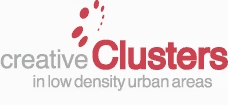
The URBACT network on Creative Clusters in Low-Density Urban Areas is an added value cooperation project with the goal to perform a collective “learning by doing” exercise in the field of urban creative clusters. The fundamental assumption is that creative issues in local economic development are also a functional pattern outside the context of the main urban hubs and core cities. Even more, creativity as source of innovation should act as a cross cutting approach to re-think economic and social development in middle size and small towns given the new opportunities related to accessibility, community life, culture and creativity-based business models.
In this framework the concept of “low density urban areas” will match with both: the OCED concept of “intermediate region”; and the remoteness/ proximity duality, or accessibility to a main urban hub, rejecting the urban/rural duality.
As a result of the work carried out during the development phase, five key sub-themes have been selected in order to focus the collective work of the partnership during the implementation phase (2009-2010):
- Creative clusters: diversifying local economic base & opportunities to young people. The partnership will face not only the impulse of new emergent clusters in creative industries but also to use the creative issue to re-think some mature local industries in order to foster them with a new growth potential. Also, the challenge of job creation and employment opportunities especially for young local people will be an important issue to deal with.
- Events and cultural agendas as catalysts. Culture and cultural life as key ingredients for addressing the creative city. A common assumption within the whole partnership is to blur the limits between the cultural and the economic development policies at the urban scale.
- Promoting the creative city: a new range of facilities and infrastructures. This will be the more physical dimension of the work of the partnership. Different scales will be considered: from adapting public spaces and city centres to creative activities [where the mixing of land-uses is crucial as opposite to the past zoning schemes], cultural districts… always placing people at the core, to a new generation of facilities to creative business and entrepreneurs. Here the potential role of the associated Managing Authorities participating in the ad-hoc financial schemes for this kind of local investment will be crucial.
- Creative entrepreneurs and talented people: attraction and retaining. Packaging financial and advising support measures specifically adapted to creative entrepreneurs and businesses. Branding the creative place will be considered here, as a framework for a smart and focused diffusion of these support tools.
- Setting the basis: creative education environments at local levels. It must be underlined that many of the cities approaching seriously the creative paradigm are displaying innovative and creative local education systems in primary and secondary levels. In this field Reggio Emilia is an benchmark at World level, but also Óbidos or Barnsley are being active introducing advanced methods in public education. It is relevant to diffuse these practices to the whole partnership.
A time to evaluate and move forward
The Creative Clusters Network is in the striking point. It is time to evaluate and move forward by reinforcing the dynamics and continuing to generate new or recycled policies for our territories. We are now seeing the horizon more clearly. Time is moving fast. While we are producing the necessary documentation (progress reports, local action plans) the world does not stop, however creativity and innovation are still in the agenda of a new atmosphere.
If you think like a creative person you probably don’t believe in inevitabilities! Thus, one of the expressions you will probably never hear in this project is a ready to use solution. Nevertheless, it is possible to learn, share and create, based on all of our experiences. Even though some of the solutions we need are all different, some of the problems are similar. The debate is underway and URBACT Creative Clusters Network is in the middle, helping in the conquest for innovation. Our presence in the European Forum of Cultural Industries in Barcelona demonstrated the acuity of our objectives and has brought us enormous responsibility for our future work.
Maybe, we are changing the paradigm and facing the paradox of creative and technological companies. Growing sometimes makes you more inflexible, less creative, having to face difficulties and more dependent on major political solutions. However, being small can also become an advantage. Low density urban areas present strong identities, different backgrounds, specific paths, strong leadership and, mainly, an active attitude towards facing challenges. Let us contribute with the attitude to change the global frame.
Miguel Silvestre – Lead Partner
creativeobidos@cm-obidos.pt
